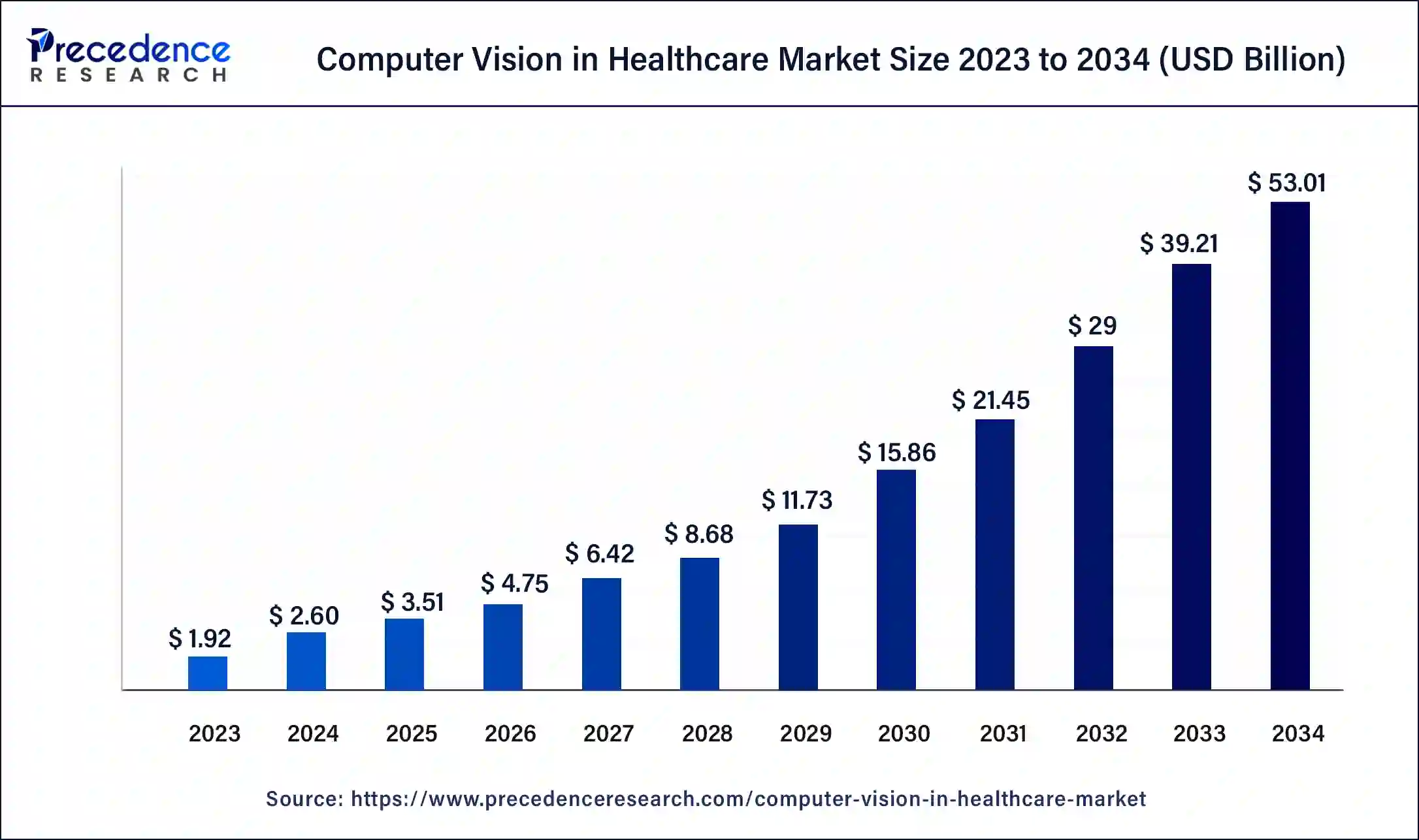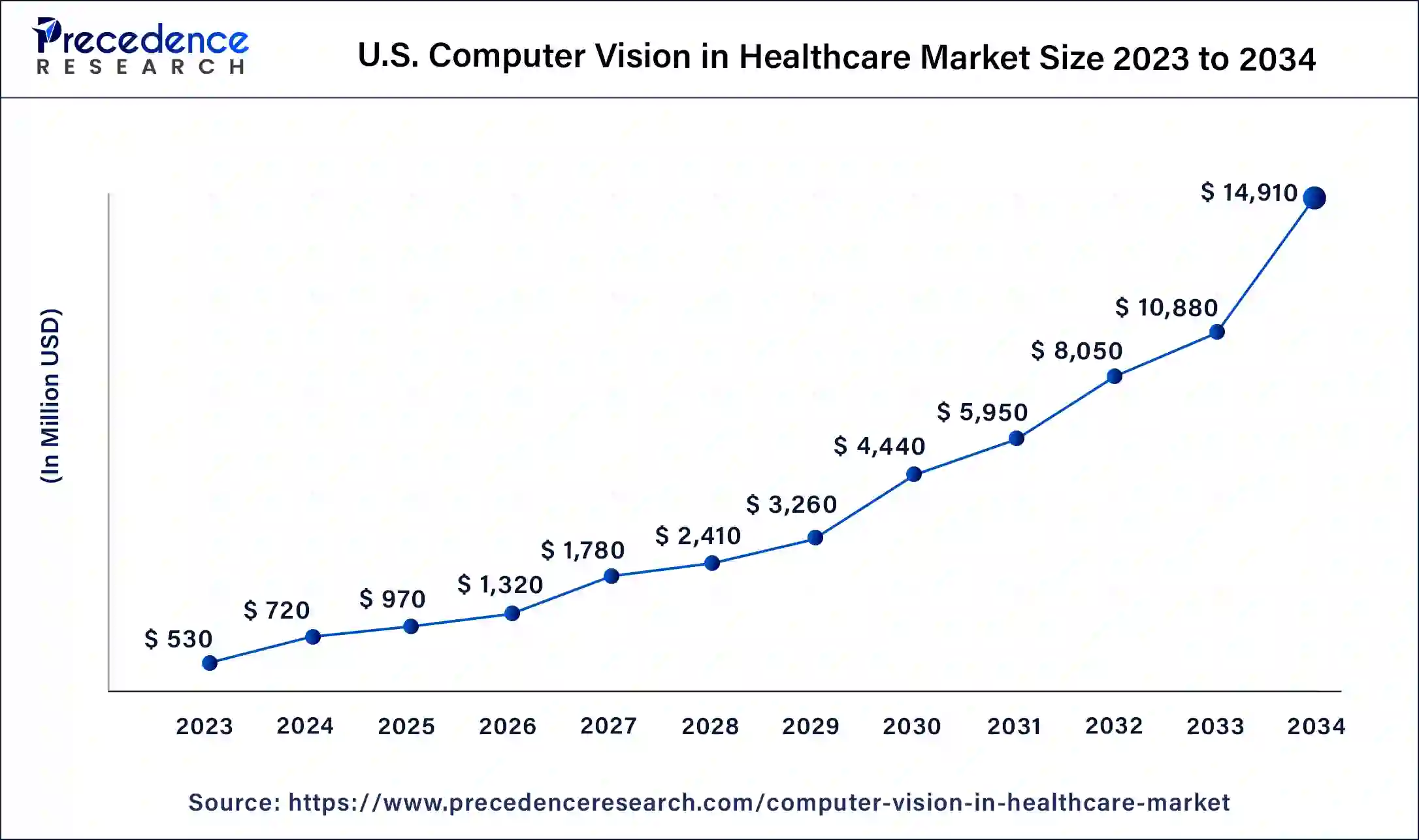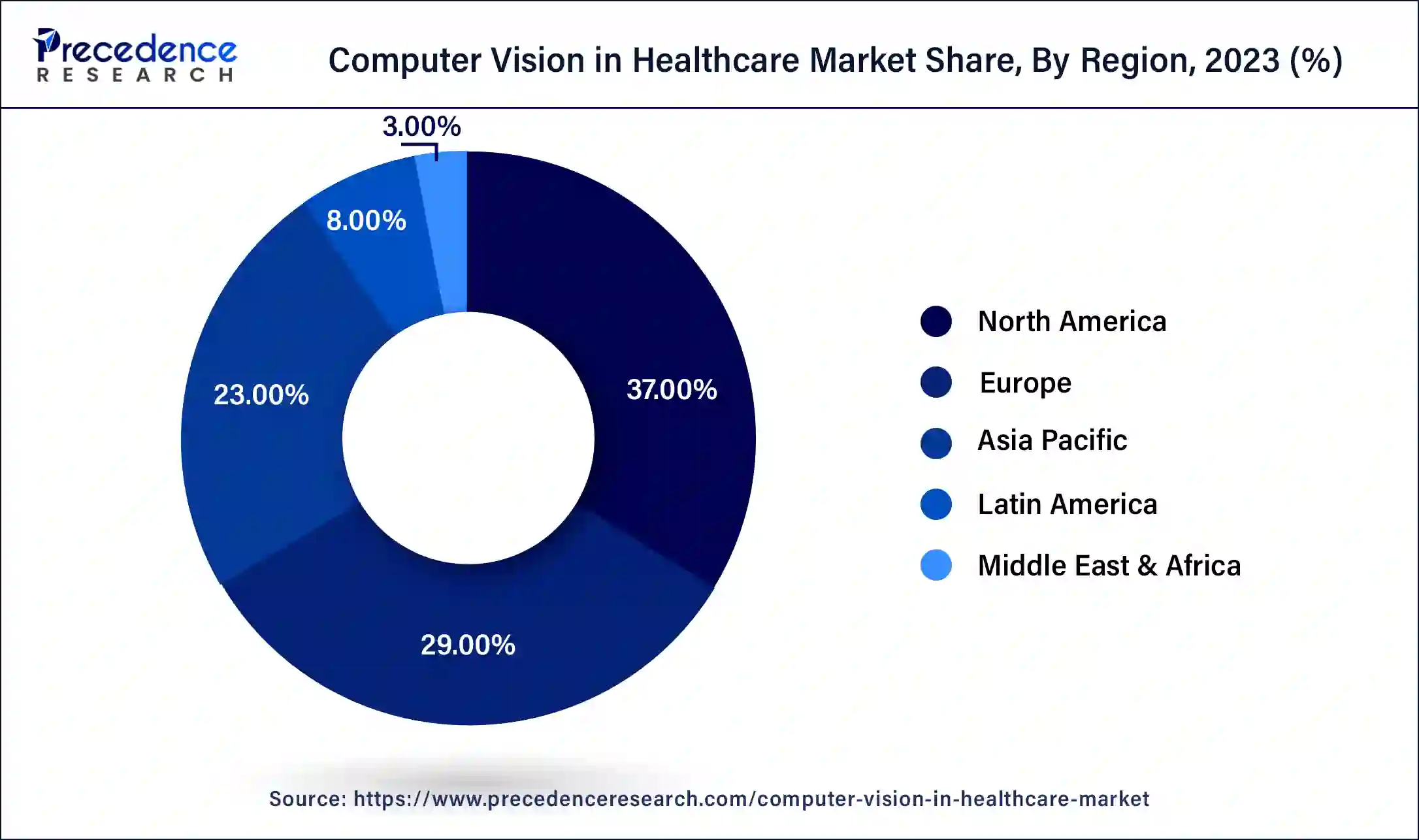March 2025
The global computer vision in healthcare market size surpassed USD 1.92 billion in 2023 and is estimated to increase from USD 2.60 billion in 2024 to approximately USD 53.01 billion by 2034. It is projected to grow at a CAGR of 35.21% from 2024 to 2034.
The global computer vision in healthcare market size is projected to be worth around USD 53.01 billion by 2034 from USD 2.60 billion in 2024, at a CAGR of 35.21% from 2024 to 2034. The North America computer vision in healthcare market size reached USD 710 million in 2023. Increasing demand for personalized treatments is driving the growth of computer vision in healthcare market.

The U.S. computer vision in healthcare market size was exhibited at USD 530 million in 2023 and is projected to be worth around USD 14,910 million by 2034, poised to grow at a CAGR of 35.43% from 2024 to 2034.

North America dominated the computer vision in healthcare market in 2023 owing to the early adoption of technologies into the various end-use sectors, and healthcare is one of the well-developed industries in the regional countries that are contributing to the growth of the market. The increasing cases of severe chronic illnesses like cardiovascular diseases, asthma, cancer, diabetes, and others are driving the demand for enhanced technologically advanced diagnostics and treatment procedures that drive the growth of the market. Additionally, the rising adaptation of artificial intelligence, machine learning, deep learning, and other advanced technologies into healthcare services is driving the growth of computer vision in the healthcare market in the region.

Asia Pacific is expected to witness significant growth in the computer vision in healthcare market during the forecast period. The growth of the market is attributed to the rising investment in the development of healthcare sectors in regional countries like India, China, and Japan, and the continuously evolving population of the region is driving the demand for the healthcare industry. The rising penetration of chronic illness in the elderly population and the rising cases of cancer, tumors, and other severe diseases in the population are driving the growth of computer vision in the healthcare market in the region.
Computer vision technologies are the recent technology in artificial intelligence that works to revolutionize human and machine partners. The healthcare industry is one of the significant areas in which computer vision is rising. Computer vision is a highly developed technology that is transforming the services in the healthcare industry. Computer vision uses technological advancements like artificial intelligence algorithms with optical cameras and sensors.
Computer vision is transforming the medical industry, aiming to help medical professionals and doctors rapidly identify and diagnose diseases, provide personalized treatment for patients, provide accurate diagnoses, predict health outcomes, and monitor medication use. The integration of AI into healthcare enhances the speed of physicians and increases value-based care. Thus, the rising integration of technologies into the healthcare sector is driving the growth of the computer vision in healthcare market.
Application of AI in Computer Vision
AI is having a profound effect on computer vision in healthcare market by increasing computer vision capabilities for more precise diagnosis and tailored treatment based on personal health history of the individuals. AI can be helpful in medical imaging. AI-based computer vision algorithms are able to analyze X-rays, CT-scans and MRIs with accuracy by identifying patterns in it and anomalies presence in the data. Such early detection of the disease can help in life-threatening diseases like cancers and lead to better treatment plans.
Furthermore, in surgical process, time is crucial hence, AI models can assist with real- time data analysis for images which helps surgeons for better visualization improving precision and reduce risks associated with it.
Additionally, AI models are being used to predict skin conditions with the help of images for accuracy, for quick decisions to treat the exacerbating skin conditions.
| Report Coverage | Details |
| Market Size by 2034 | USD 53.01 Billion |
| Market Size in 2023 | USD 1.92 Billion |
| Market Size in 2024 | USD 2.60 Billion |
| Market Growth Rate from 2024 to 2034 | CAGR of 35.21% |
| Largest Market | North America |
| Base Year | 2023 |
| Forecast Period | 2024 to 2034 |
| Segments Covered | Component, Application, End-user, and Regions |
| Regions Covered | North America, Europe, Asia-Pacific, Latin America and Middle East & Africa |
Rising adoption of computer vision in cancer detection
Computer vision is leveraging artificial intelligence and machine learning into the healthcare sector for early detection and diagnosis of disease, personalized treatment, and accuracy in the treatment, which is driving the growth of computer vision. Computer vision is rapidly evolving in the early detection of cancer and its diagnosis. AI and machine learning are used in medical imaging to monitor and detect the growth of tissues.
Computer vision is trained on the large database, which makes it efficient in detection and categorization tasks and helps in identifying the abnormalities in the tissues and polyps and detecting whether the tumor is malignant or benign. Computer vision helps doctors to early scan the signs of cancer. The rising cases of types of cases in the population, such as the rise in skin cancer and breast cancer, are driving the demand for technologically advanced diagnostics procedures that drive the growth of the computer vision in healthcare market.
Lack of awareness
The lack of awareness of computer vision and medical imaging in healthcare in rural areas and the higher cost of medical procedures due to the integration of technologies like artificial intelligence, machine learning, and others that increase the cost of the procedure is restraining the growth of the computer vision in healthcare market.
Advancements in computer visions
The rising advancements in computer vision, such as 3D computer vision, are driving the opportunities in the market’s growth. 3D computer vision includes multiple cameras that are used to capture the various angles of light sensors and objects to measure the time of light reflection. 3D visualization helps in the accurate treatment and diagnosis of the disease. 3D imaging helps medical professionals to make more informed and accurate decisions for the patient’s treatment.
Additionally, the rise in automation in healthcare services helps enhance the accuracy of treatment with the speed and cost reduction in the services, and the rising integration of AI, machine learning, and other technologies in healthcare is driving growth opportunities in the computer vision in healthcare market growth.
The software segment held the highest share of the global computer vision in healthcare market in 2023. The growth of the segment is attributed to the rising adoption of computer vision software in healthcare to enhance disease identification and diagnosis, improve treatment accuracy, and customize medicinal care. Computer vision software works in the different sectors of healthcare, such as patient monitoring, medical education, medical imaging, better image analysis, cancer detection, hospital hygiene, tumor detection, abnormality detection in radiology, diagnosis assistance, Oxipit, hospital management, cancer detection, surgical procedures, early diseases diagnosis, blood loss measurement, and timely detection of underlying medical solutions.
Cloud-based software solutions are seeing significant growth in the computer vision in healthcare market. The rising adoption of cloud-based software solutions is attributed to their higher accessibility, scalability, and cost-effectiveness. This type of software helps analyze and assist healthcare professionals in maintaining diagnostics remotely. The increased compatibility, flexibility, and scalability of the cloud-based software solutions drives the demand for the cloud-based software solutions.
The medical imaging & diagnosis segment led the global computer vision in healthcare market in 2023. The growth of the segment is attributed to the rising implementation of medical imaging and diagnosis in modern healthcare facilities due to its higher accuracy and valuable insights that aim to help healthcare professionals detect and diagnose diseases. The rising adaptation of computer vision into medical imaging and diagnosis is fostering the growth of medical imaging in the healthcare sector.
Medical imaging mainly consists of non-invasive imagery technologies that take medical images of the different parts of the body. There are several benefits associated with medical imaging. The integration of AI into medical imaging helps in identifying and early detection of diseases, and early detection helps in the timely diagnosis of diseases before the full development of diseases. Medical imaging is AI that helps in detecting various abnormalities like cancer, tumors, strokes, pneumonia, COVID-19, and others.
The hospitals & clinics segment held the largest share of the computer vision in healthcare market in 2023 and is expected to maintain its position during the forecast period. The growth of the segment is attributed to the rising adoption of hospitals and clinics for the treatment and diagnosis of various diseases due to the higher availability of skilled and trained healthcare professionals and the presence of technologically advanced diagnostics machines.
Computer vision is highly adopted by pathologies, and clinical facilities are driving the growth of healthcare facilities. The rising investment by public and private firms for the development of healthcare facilities like hospitals and clinics is further driving the installation of various technologies in diagnostics procedures that contribute to the growth of the market.
Segments Covered in the Report
By Component
By Application
By End-user
By Geography
For inquiries regarding discounts, bulk purchases, or customization requests, please contact us at sales@precedenceresearch.com
No cookie-cutter, only authentic analysis – take the 1st step to become a Precedence Research client
March 2025
March 2025
April 2025
September 2024